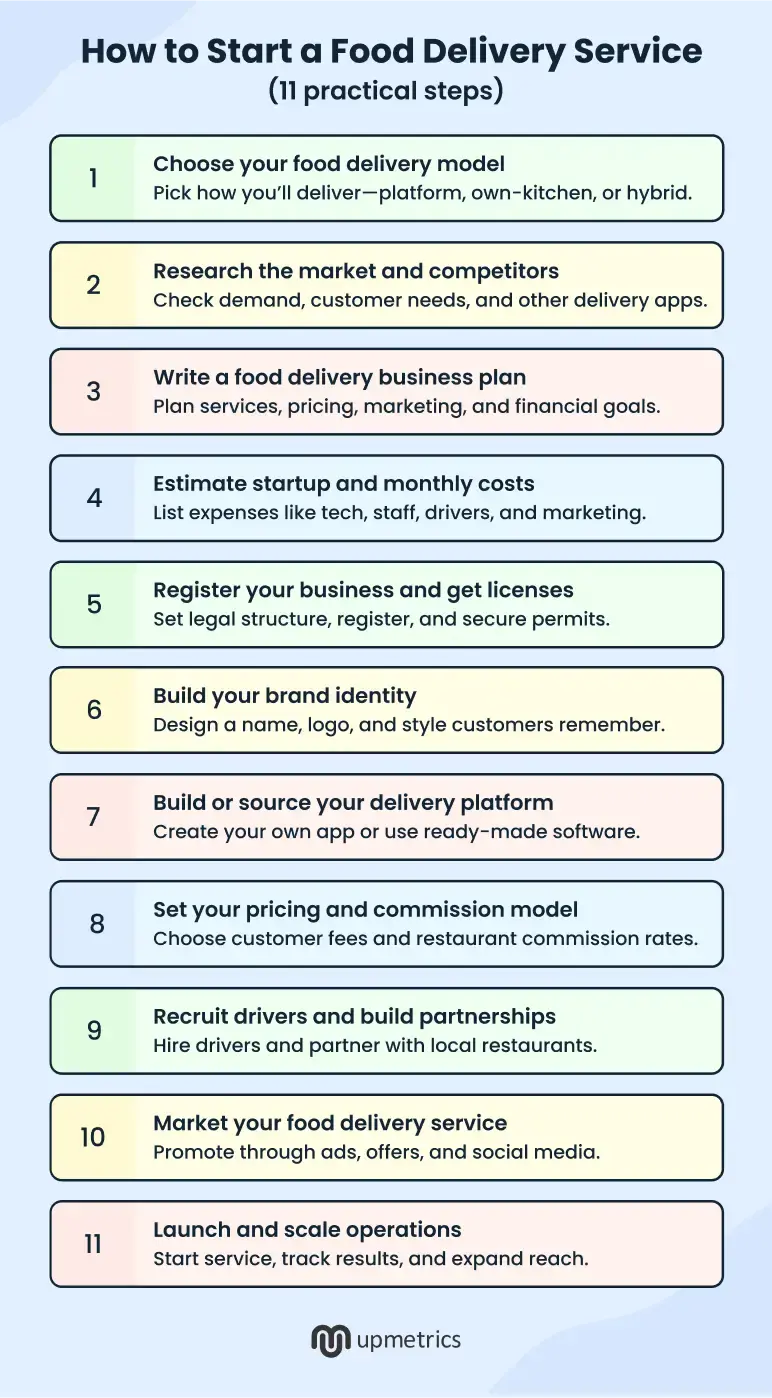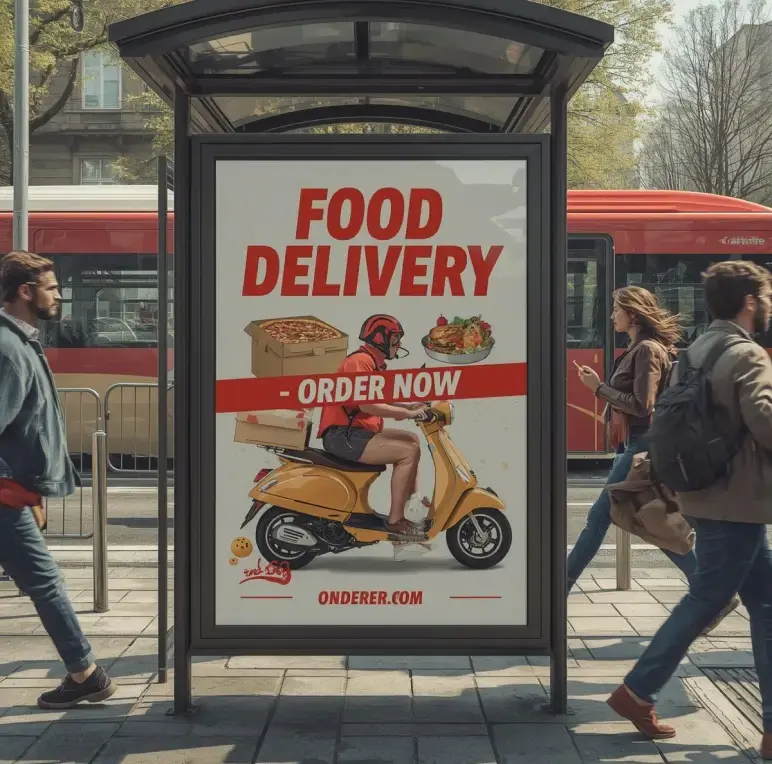Uber Eats and DoorDash make it look like anyone can start a food delivery business—and with all the tools and resources available today, that’s partly true. Running your own delivery service is exciting and absolutely possible.
But then the questions start piling up:
- How much capital do I need?
- Is it even worth it with all the big players?
- And where do I even begin?
That’s exactly what this guide is for.
I’ll show you the exact steps to start a food delivery service the smart way. We’ll cover everything from choosing a business model and estimating costs to legal setup, technology, recruiting drivers, pricing, marketing, and scaling.
If you’ve been thinking about launching your own food delivery business, this roadmap will give you the clarity and confidence to get started—and avoid the common mistakes new founders make.
Key Takeaways
- Starting a food delivery service can cost $10k–$100k or more.
- Choose the right model: Platform, own-kitchen, or local hybrid.
- Plan for ongoing costs like drivers, insurance, and marketing.
- Start local, market simply, and build trust with restaurants and customers.
How much does it cost to start a food delivery service?
The cost depends on how big you want to go:
- Small local service: Around $10,000–$20,000 (using a few drivers and a basic setup).
- Large platform: Around $50,000–$100,000+ (building your own app, hiring many drivers, and running bigger operations).
Your exact cost will vary based on your city, the delivery model you choose, the number of drivers you need, and the licenses or permits required in your area.
Now, let’s move on to the step-by-step guide for starting your own food delivery service.
How to start a food delivery service (11 practical steps)
There’s a lot involved when it comes to starting a food delivery service. While I can’t cover everything in a 3500-word blog, I’ve narrowed down the entire process and curated this simple, 11-step guide for you.

From choosing your delivery model to setting up your business and marketing it, this guide has potentially all the information you’d need to enhance your understanding of what’s required and where do you stand.
Step 1: Choose your food delivery model
Your first big decision is the type of delivery service you’ll run. This choice sets the direction for your business—costs, tech, licenses, and even marketing all depend on it.
You’ve got three main options:
| Model | How it Works | Pros | Cons |
|---|---|---|---|
| Platform model (like Uber Eats or DoorDash) | You connect restaurants and customers, and earn through commissions. | No food handling, scalable, and works with many restaurants. | High tech cost, strong competition, and makes it hard to stand out. |
| Own-kitchen model (like meal prep delivery or cloud kitchens) | You cook and deliver meals yourself. | Full control over menu, quality, and pricing. | Higher setup cost, need kitchen, staff, health permits, and more liability. |
| Hybrid/local model | You partner with a few restaurants and handle delivery yourself. | Easier to start, cheaper than a full platform, strong local connection. | Limited growth potential, logistics can get tricky as you scale. |
👉 I’ve noticed many new owners begin with the hybrid model because it’s simple and affordable. But the right choice depends on your budget, goals, and how much control you want.
Step 2: Research the market and competitors
Before you spend money, check what’s already happening in your area. Some cities are full of delivery apps, while others have big gaps. I’ve found that doing this early helps you see where you can stand out.
Things to check:
- Existing players: Which delivery apps are people using in your city (Uber Eats, DoorDash, or smaller local ones)?
- Coverage areas: Are there neighborhoods or towns not covered well?
- Prices and fees: What do they charge customers for delivery? How much do they take from restaurants?
- Customer reviews: Are people upset about slow delivery, high prices, or missing items?
- Restaurant partners: Do most local restaurants already use big apps, or are there many still independent?
👉 The goal isn’t just to copy what others do, but to find the weaknesses you can fix. For example:
- If big apps charge restaurants 30%, you could charge 15–20%.
- If deliveries take 45 minutes, aim for 25 minutes.
- If nearby towns have no coverage, you could focus there.
This research saves you time and money later, and makes sure your service is something people really need.
Step 3: Write a food delivery business plan
A business plan isn’t just paperwork; it’s your blueprint. It helps investors and lenders understand your idea, and it keeps you on track as you build your service. What many successful founders do is start with a clear plan; skipping it often leads to confusion or wasted effort.
Here’s what your plan should include:
| Section | What to Decide |
|---|---|
| Delivery Model | Platform, own kitchen, or local hybrid setup |
| Service Area | Neighborhoods, zones, or cities you’ll cover |
| Target Customers | Families, office workers, students, or late-night eaters |
| Pricing | Delivery fees for customers and commission from restaurants |
| Fleet | Employees for control or freelancers for flexibility |
| Technology | Custom app, white-label software, or simple website |
| Marketing | Flyers, local ads, social media, or referral programs |
Think of your food delivery business plan as a roadmap. Without it, you’re guessing. With it, you have clear steps to follow and proof that you’re serious. Many founders find that even a simple one-page plan makes running the business much easier.
Not very good at writing? Need help with your plan?
Write your business plan 10X faster with Upmetrics AI
Plans starting from $14/month

Step 4: Estimate startup and monthly costs
Don’t guess when it comes to money. Many new delivery businesses fail because they don’t plan for all the costs. You need to look at two things: one-time startup costs and ongoing monthly costs.
One-time startup costs:
- Business registration and licenses
- Branding
- App or website setup (custom or white-label)
- Insurance deposits
- Office or storage space (if needed)
A small, local setup might cost $10,000–$20,000 to get going. Building a full platform with your own fleet can take $50,000–$100,000+.
Ongoing monthly costs:
- Driver pay ($4–$8 per delivery on average)
- Insurance (business and vehicles)
- Marketing and ads
- App or website hosting and updates
- Fuel or vehicle costs (if you own a fleet)
- Customer support
Most new businesses struggle with these ongoing costs. I recommend having enough money to cover at least 6–12 months of expenses before your income becomes steady. That way, you can focus on growing without constant financial pressure.
Step 5: Register your business and get licenses
This step is essential. Registering your business isn’t just paperwork; it makes your food delivery service official and legal. Because food delivery involves health, safety, and drivers, the rules can be stricter than expected. I’ve seen new businesses run into trouble when they skip this step.
First, register your business and choose a legal structure, such as a sole proprietorship, LLC, or a Corporation.
Next, get the needed licenses and permits:
- Business license – Makes your company official in your city or state.
- Food handling permits – Required if you cook or prepare meals.
Finally, get insurance to protect yourself:
- Liability insurance – Covers you if something goes wrong.
- Driver and vehicle insurance – Needed if you run your own fleet of drivers.
Handling this step carefully from the start can save a lot of headaches later. Checking local rules and making sure everything is in place keeps your business safe, legal, and trustworthy.
Step 6: Build your brand identity
Your brand is what people think of when they hear about your service. In food delivery, trust is everything. Customers want food that comes on time, and restaurants want to work with a service that looks reliable. A good brand helps you earn that trust.
Start with the name. Pick something short and easy to say. It should be simple to spell and remember. If it also suggests food or speed, that’s even better. Avoid long or confusing names.
Next, create a logo. Keep it clean and simple. Your logo should look good on a website, an app, a delivery bag, or even a driver’s t-shirt. Use clear text and colors that stand out. Don’t make it too complex.
Then, write your value proposition. This is one short line that explains why people should choose you instead of others. Some examples are:
- “Faster delivery in your area.”
- “Helping local restaurants with lower fees.”
- “Fresh meals delivered at fair prices.”
This step may look small, but it matters. A clear name, logo, and value proposition will help you stand out and make both customers and restaurants take you seriously.
Step 7: Build or source your delivery platform
Your technology is the backbone of your food delivery service. This is how people place orders, how restaurants connect, and how drivers get tasks. Choosing the right option at the start will save you money and stress later.
You have three main choices:
- Build your own app
- You hire developers to make a custom app.
- You control everything about the design and features.
- But it costs a lot (often tens of thousands of dollars) and takes months to finish.
- Use white-label software
- This is ready-made software that you can put your own name and logo on.
- It’s much faster and cheaper than building from scratch.
- You still get important features like customer ordering, restaurant dashboards, and driver tracking.
- Start small
- Use a simple website, phone calls, or WhatsApp to take orders.
- Coordinate drivers manually in the beginning.
- This is cheap and helps you test if people want your service before spending big.
I’ve found that starting simple and scaling as demand grows works best for most new delivery services. Don’t overspend on technology at the start, match your tech investment to the size of your business, prove the idea works, and then upgrade.
Step 8: Set your pricing and commission model
How you charge money is one of the most important parts of your business. Your pricing strategy decides if customers stay, restaurants join, and if you make a profit. In food delivery, there are three main ways to earn:
1. Delivery fees
One of the easiest ways to earn is through delivery fees. Customers pay a small fee per order—DoorDash charges $2–$6, while Uber Eats charges $1–$8. The key is to cover driver pay, fuel, and other costs without scaring people away. Start with a moderate fee and adjust as you see what your market accepts.
2. Restaurant commissions
You also earn by taking a cut from restaurants, usually 15%–30% per order. Too high, and restaurants might not join; too low, and you won’t make enough profit. A smart move is to check what local competitors charge, offer a fair starting rate, and adjust gradually as your platform grows.
3. Subscriptions
Subscriptions give a steady income and help keep customers loyal. You could offer $5–$15 per month for free or discounted delivery. Restaurants might pay more to be featured higher.
Balance is key: too expensive and people won’t sign up; too cheap and it won’t cover costs. Try different price points and perks to find the sweet spot.
Think of it as walking a tightrope; test, adjust, and find the middle point where everyone wins.
Step 9: Recruit drivers and build partnerships
Your delivery business depends on people—the drivers who deliver orders and the restaurants who trust you with their food. Building these relationships the right way will shape how smooth your service feels for customers.
For drivers, there are two choices: hiring employees & working with freelancers.
Here’s a simple comparison:

Many delivery services start with freelancers, then add employees as the business grows.
For restaurants, trust matters most. They need clear deals so everyone knows what to expect.
Be open about delivery times, commission rates, and packaging standards. Restaurants want their food to reach customers fast, fresh, and in good shape. When they trust you, they’ll promote your service to their customers too.
In the end, both drivers and restaurant partners are more than just “helpers.” They’re the face of your business. Treat them fairly, keep communication open, and your delivery network will grow strong.
Step 10: Market your food delivery service
Marketing a food delivery service is not about big ads when you’re new. It’s about being seen in your own neighborhood and slowly building trust. Your first goal isn’t thousands of downloads, it’s finding 100 loyal customers who will order again and again.
Start small and visible. Hand out flyers in busy places like apartments, colleges, and offices. Put posters in local spots where people already spend their time. Here’s an example:

These simple touches remind people you’re nearby and easy to reach.
Show up at community events like school fairs, markets, or local gatherings. A friendly face, a discount code, or even free samples go a long way. I’ve found that people remember services that feel close and personal.
Online visibility matters too, but keep it local. Ensure your business shows up when someone searches for “food delivery near me.” Add your name to Google Maps and use your city or neighborhood in your website text.
If you want to run ads, keep them small. A few dollars a day on Facebook, Instagram, or Google is enough at first. And don’t forget referrals. Customers trust friends more than ads.
Win your area first. Scale later.
Step 11: Launch and scale operations
When it’s time to launch, don’t think about big events or flashy announcements. A food delivery service doesn’t win because of a “grand opening”; it wins because customers get their food on time, in good condition, and without hassle.
Start small. Test your system with a limited number of restaurants and delivery zones. Mistakes will happen, orders may be late, tech may glitch, or packaging might fail. From what I’ve seen in new services, this early stage is where most learning happens.
Use this stage to learn and fix problems before more people are watching. Early bad reviews can hurt a new service more than slow growth ever will.
Once you’re confident the basics are working—orders flow smoothly, drivers are reliable, and restaurants are happy, you can begin to scale. Scaling doesn’t always mean going nationwide. It can be as simple as:
- Expanding to nearby neighborhoods.
- Adding more restaurant partners to increase choice.
- Upgrading your tech with new features like live tracking or better payment options.
Always grow in steps, not leaps. Reliability matters more than speed. Customers won’t remember if you scaled fast, but they’ll remember if their first order arrived late or cold. Get it right small, then grow bigger.
Things you should never do when starting a food delivery business (5 biggest mistakes)
Starting a food delivery service looks simple, but many new founders hit the same roadblocks. The good news? If you know these mistakes early, you can avoid most of the pain.
1. Copying big platforms without a plan
Many new owners rush to start a delivery app because they think it’s just about drivers and an app. But big players like Uber Eats or DoorDash spend millions to grow. Trying to copy them without a clear plan usually means wasted money and no loyal customers.
Decide early. Are you a platform connecting restaurants, a kitchen making your own meals, or a hybrid running locally? Your costs, tech, and drivers all depend on this choice. Without it, you’ll be stuck trying to run three different businesses at once.
2. Forgetting about ongoing costs
I’ve seen new founders get excited about launch budgets, paying developers, designing logos, even renting office space, only to run out of money within months. Why? They forgot about the “every month” costs like driver pay, insurance, software fees, and marketing. Customers don’t appear overnight, and bills don’t wait.
Budget for 6–12 months of ongoing costs before you launch. That way, you won’t panic when growth is slower than expected. Ongoing money management is what separates services that survive from the ones that quietly disappear.
3. Hiring the wrong drivers
Drivers are not just people moving food, they’re your brand on the doorstep. Many beginners think, “I’ll just hire freelancers; it’s cheap.” But when drivers show up late, get lost, or treat customers poorly, it’s your name on the review, not theirs.
Be careful about who you bring on. Employees give you more control but cost more. Freelancers are flexible but harder to manage. Train all drivers in customer service, not just delivery speed. A polite hello at the door goes further than any ad campaign.
4. Partnering with restaurants blindly
It’s exciting when restaurants want to join your platform. But not every partner is good for your brand. If they delay orders, use bad packaging, or cancel at the last minute, the customer doesn’t blame them—they blame you.
Start with a handful of trusted partners. Set clear agreements: delivery times, packaging standards, and commission terms. It’s better to have five reliable restaurants than 50 that damage your reputation.
5. Believing “If I launch, customers will come”
Many owners think building a nice-looking app or website is enough. But if no one knows your service exists, you won’t get orders. Even a great location or strong restaurant lineup won’t matter without marketing.
Focus on local visibility. Put up flyers, join community events, list yourself on Google Maps, and run small targeted ads. Simple referral programs like “Give $5, Get $5” work wonders. Customers don’t magically find you. You have to meet them where they already are.
Final Thoughts
Starting a food delivery service is a good way to serve your area and make a steady income. It feels good to bring people the food they want and help local restaurants get more orders. At the same time, you’ll face challenges, like paying drivers, setting fair prices, keeping orders on time, and competing with bigger apps. That’s normal for this business.
Having a clear plan makes things much easier. With Upmetrics, you can make your food delivery business plan quickly. From startup costs to pricing and marketing, Upmetrics gives you tools to stay on track, avoid mistakes, and grow with confidence.
Keep your service simple, give fair prices, and focus on good service. If you plan well and stay reliable, your food delivery business can become a trusted choice in your community.
The Quickest Way to turn a Business Idea into a Business Plan
Fill-in-the-blanks, AI-assistance, and automatic financials make it easy.


